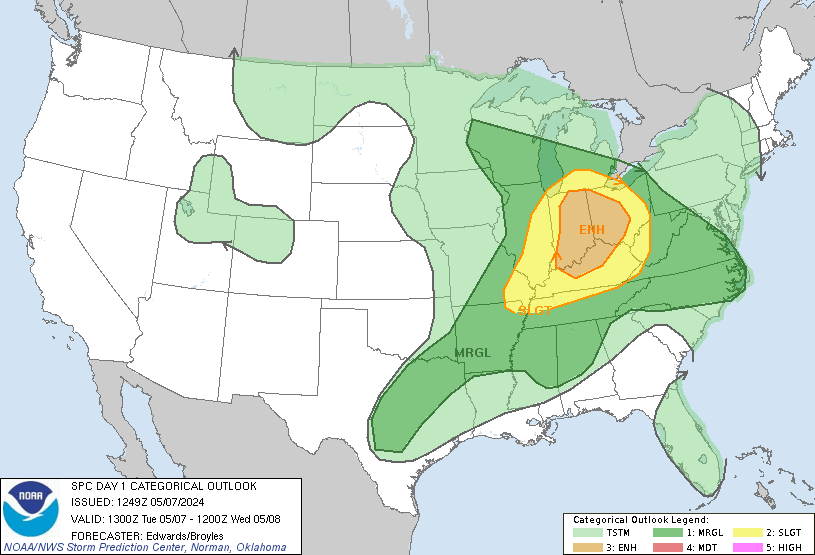On Saturday February 28th of this year we saw another example of a strong tornado produced in a low instability high shear environment across East Central Alabama. Many times when we look at the threat of severe weather in the meteorological world we look for high levels of CAPE(Convective Available Potential Energy) and shear to outline an area where the greatest threat is. But there have many instances where we have seen low level of CAPE that produced strong tornadoes. The Salem, AL EF-2 tornado is just another example of why need to look at all severe weather parameters to determine the severity of impending storms.

So let’s take a look at the conditions that came together to form this severe weather event. Tornado watches were in effect throughout the early morning hours Saturday for the possibility of isolated tornadoes to form, especially along a northward moving boundary of increased moisture. In the image below you can see an area of dark green (or higher dew points) indicating a boundary between very moist are and slightly drier air to the north. This boundary was slowly moving to the north and along it, low level helicities, or atmospheric spin, would increase leading to the possibility of tornadoes.

With the added moisture to the south of this boundary, instability levels increase, as shown by the orange shading indicated LI’s of -2°C. Now this value of instability is not all that great but, when you combine it with other atmospheric conditions, severe weather can occur.

By looking at the previous two images you will notice the surface winds are out of the southwest around 15 knots. As you move up the atmosphere winds along this boundary winds were also out of the southwest and then eventually out of the west setting up what we call unidirectional shear. Usually we look to have directional shear, or winds form different direction and speed as we move up in the atmosphere. Something we must factor into the storms environment is the relative winds associated with that particular storm. In the image below, storm relive 1KM winds are indicated or, the inflow to the storm. You will notice that right along the edge of the boundary, the relative inflow backs, or turns counter-clockwise, to the southeast. This increases the storm’s relative helicity and gives the storm a better chance of producing a tornado.

As stated earlier, many times weather enthusiasts look for area of high CAPE to determine where the most severe weather will occur. CAPE basically shows the buoyancy of air. The larger the number, the faster the air will rise. We look for areas of rapid upward motion for the development of severe thunderstorms. In my opinion, many times we get caught up in just looking at areas of high CAPE and not focusing on all aspects of the storm’s environment. Prime example of this is looking at the amount of CAPE that was available for Saturday’s storms. The image below shows the surfaced based CAPE, or buoyancy available from a parcel of air lifted from the surface, was just over 500 J/kg in Lee County.

We normally look for CAPE values to be greater than 1500 J/kg for severe weather and tornadoes. But when we look at where the 500 J/kg of CAPE is located in the profile of the atmosphere and what is happening through that layer, we get a much better indication of what can happen. In the image below we can see the 0-3KM CAPE, or the amount of buoyancy from the surface to 3KM in the atmosphere, is greater than 160 J/kg. This is a fairly significant amount of CAPE for such a shallow layer of the atmosphere.

When we look at a volumetric scan of the storm as the updraft was located near Chewacla State Park, we can see the high reflectivity colors, or red, do not exceed very far beyond the 3KM mark in the atmosphere. In “text book” supercell producing thunderstorms we usually look for these areas of high reflectivity to exceed 30,000’, three times higher than the storms of this day.

So what was occurring in the 0-3KM layer of the atmosphere that lead to the development of a strong EF-2 tornado? As stated earlier, the storm relative winds were backing to the southeast in the 1st KM layer of the atmosphere. This lead to an increase in the storm relative helicity(SRH) values the storm would experience as it moved into Lee County. Notice in the image below that 0-3KM SRH were over 300 in Lee County at the time the storm was west of Auburn.

This large amount of helicity was in the same layer of the atmosphere where the buoyancy, CAPE, was the greatest. So where the updraft of the storm was the strongest, there was enough spin in the atmosphere to produce a strong mesocyclone located in the radar image below which lead to the formation of a strong EF-2 tornado in Salem a few minutes later.

So the right combinations of ingredients came together to produce a tornado who’s estimated wind speed was around 130 mph. If we were to just have looked at the CAPE and wind flow throughout the atmosphere, we might have missed the threat for a strong tornado. But by looking at all aspects needed for tornado development, we can see it does not take much CAPE to produce a significant tornado under the right conditions.








































